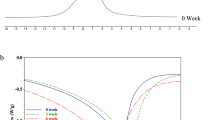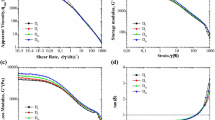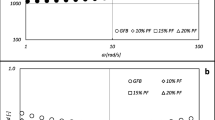Abstract
In this paper the effects of frozen storage time, xanthan gum and rate of freezing on frozen sweet dough properties and unfermented bread quality was investigated. Results revealed that the water holding capacity, WHC, K1 (stress decay rate) and K2 (residual stress at the end of the stress relaxation experiment) values of frozen dough decreased with increasing frozen storage time and decreasing freezing rate; while the lowest values for these parameters were obtained for samples without xanthan gum. The amount of unfreezable water increased and freezable water decreased with addition of xanthan gum. Glass transition temperature for fresh or frozen sweet were around −37 and −39 °C, respectively. Addition of xanthan gum increased the glass transition temperature of fresh and fozen sweet dough. Firmness and gumminess of sweet bread increased during frozen storage which led to lower specific volume of frozen sweet bread. Increasing freezing rate and addition of xanthan gum to dough formulation improved the texture and specific volume of the final bread.


Similar content being viewed by others
References
Angioloni A, Balestra F, Pinnavaia GG, Rosa MD (2008) Small and large deformation tests for the evaluation of frozen dough viscoelastic behavior. J Food Eng 87:527–531
Asghar A, Faqir MA, Jonathan C, Christopher R, Daubert GR (2009) Effect of modified whey protein concentrates on empirical and fundamental dynamic mechanical properties of frozen dough. Food Hydrocoll 23:1687–1692
Bhattacharya M, Langstaff TM, Berzonsky WA (2003) Effect of frozen storage and freeze-thaw cycles on the rheological and baking properties of frozen doughs. Food Res Int 36:365–372
Biliaderis CG, Arvanitoyannis I, Izydroczyk MS, Prokopowich DJ (1997) Effect of hydrocolloids on gelatinization and structure formation in concentrated waxy maize and wheat starch gels. Starch/Staerke 49:278–283
Charoenrein S, Preechathammawong N (2010) Undercooling associated with slow freezing and its influence on the microstructure and properties of rice starch gels. J Food Eng 100:310–314
Esteller MS, Amaral RL, Lannes SC (2004) Effect of sugar and fat replacers on the texture of baked goods. J Texture Stud 35:383–393
Gélinas P, McKinnon CM (2004) Effect of flour heating on dough rheology. Lebensm Wiss Technol 37:129–131
Ghaitaranpour A, Elahi M, Nagafi M, Mohebbi M (2013) Changes in volume, porosity and viscoelastic properties of packaged donut during storage. In: 1st international e-conference on novel food processing, Feb 26–27
Hagar AS (2013) Cereal products for specific dietary requirements. Evaluation and improvement of technological and nutritional properties of gluten free raw materials and end products. Ph.D. dissertation, University College Cork
Hasanpour F, Hoseini E, Motalebi AA, Darvish F (2012) Effects of soy protein concentrate and xanthan gum on physical properties of silver carp (Hypophthalmichthys molitrix) surimi. Iran J Fish Sci 11:518–530
Havet M, Mankai M, Le Bail A (2000) Influence of the freezing condition on the baking performances of french frozen dough. J Food Eng 45:139–145
Hua-Neng X, Weining H, Chunli J, Yangsoo K, Huiping L (2009) Evaluation of water holding capacity and breadmaking properties for frozen dough containing ice structuring proteins from winter wheat. J Cereal Sci 49:250–253
Kaur A, Shevkani Kh, Singh N, Sharma P, Kaur SP (2015) Effect of guar gum and xanthan gum on pasting and noodle-making properties of potato, corn and mung bean starches. J Food Sci Technol 52:8113–8121
Kaur A, Shevkani Kh, Katyal M, Singh N, Ahlawat AK, Singh AM (2016) Physicochemical and rheological properties of starch and flour from different durum wheat varieties and their relationships with noodle quality. J Food Sci Technol 53:2127–2138
Kaushik R, Kumar N, Kumar Sihag M, Ray A (2014) Isolation, characterization of wheat gluten and its regeneration properties. J Food Sci Technol 52:5930–5937
Ke Sh, Hailong Y, Jue J, Tung-Ching L (2013) Improvement to baking quality of frozen bread dough by novel zein-based ice nucleation films. J Cereal Sci 57:430–436
Kim Y, Huang W, Dub G, Pan Z, Chung O (2008) Effects of trehalose transglutaminase, and gum on rheological, fermentation, and baking properties of frozen dough. Food Res Int 41:903–908
Kondakci T, Zhang JW, Zhou W (2015) Impact of flour protein content and freezing conditions on the quality of frozen dough and corresponding steamed bread. Food Bioprocess Technol 8:1877–1889
Laaksonen J, Roos YH (2000) Thermal, dynamic- mechanical, and dielectric analysis of phase and state transitions of frozen wheat dough. J Cereal Sci 32:281–292
Lu W, Grant LA (1999) Effects of prolonged storage at freezing temperatures on starch and baking quality of frozen doughs. Cereal Chem 76:656–662
Mallett CP (1993) Frozen food technology. Blackie Academic and Professional, Chapman and Hall, London
Mandala IG (2005) Physical properties of fresh and frozen stored, microwave-reheated breads, containing hydrocolloids. J Food Eng 66:291–300
Mandala I, Karabela D, Kostaropoulos A (2007) Physical properties of breads containing hydrocolloids stored at low temperature. I. Effect of chilling. Food Hydrocoll 21:1397–1406
Meziani S, Jasniewski J, Gaiani C, Ioannou I, Muller JM, Ghoul M, Desobry S (2011) Effects of freezing treatments on viscoelastic and structural behavior of frozen sweet dough. J Food Eng 107:358–365
Meziani S, Jasniewski J, Ribotta P, Tehrany EA, Muller JM, Ghoul M, Desobry S (2012) Influence of yeast and frozen storage on rheological, structural and microbial quality of frozen sweet dough. Food Hydrocoll 109:538–544
Nilufer D, Boyacioglu D, Vodovotz Y (2008) Functionality of soy milk powder and its components in fresh soy bread. J Food Sci 73:275–281
Peleg M, Normand MD (1983) Comparison of two methods for stress relaxation data presentation of solid foods. Rheol Acta 22:108–113
Rasanen J, Blanshard JMV, Mitchell JR, Derbyshire W, Autio K (1998) Properties of frozen wheat doughs at subzero temperatures. J Cereal Sci 28:1–14
Ribotta PD, Ausar SF, Beltramo DM, Leo´ n AE (2005) Interactions of hydrocolloids and sonicated-gluten proteins. Food Hydrocoll 19:93–99
Rosell CM, Gómez M (2007) Frozen dough and partially baked bread: an update. Food Rev Int 23:303–319
Rosell CM, Rojas JA, Benedito de Barber C (2001) Influence of hydrocolloids on dough rheology and bread quality. Food Hydrocoll 15:75–81
Sharadanant R, Khan K (2003) Effect of hydrophilic gums on the quality of frozen dough: II. Bread characteristics. Cereal Chem 80:773–780
Simmons AL, Smith KB, Vodovotz Y (2012) Soy ingredients stabilize bread dough during frozen storage. J Cereal Sci 56:232–238
Vania OS, Weibiao Z (2007) Frozen bread dough: effects of freezing storage and dough improvers. J Cereal Sci 45:1–17
Vittadini E, Vodovotz Y (2003) Changes in the physicochemical properties of wheat- and soy containing breads during storage as studied by thermal analyses. J Food Sci 68:2022–2027
Wu MY, Chang YH, Shiau S, Chen CC (2012) Rheology of fiber-enriched steamed bread: stress relaxation and texture profile analysis. J Food Drug Anal 20:133–142
Yang Y, Song Y, Zheng O (2011) Rheological behaviors of doughs reconstituted from wheat gluten and starch. J Food Sci Technol 48:489–494
Yi J, Kerr WK (2009) Combined effects of freezing rate, storage temprature, an storage time on the properties of frozen dough and baking performance of frozen dough. J Food Sci 42:1474–1483
Yingying X, Clifford A, Frank A (2014) Effect of flaxseed flour on rheological properties of wheat flour dough and on bread characteristics. J Food Res 3:83–91
Acknowledgements
The authors would like to thank Razavi bread Co. for their support during instrumental analysis and also for their technical assistance.
Author information
Authors and Affiliations
Corresponding author
Rights and permissions
About this article
Cite this article
Akbarian, M., Koocheki, A., Mohebbi, M. et al. Rheological properties and bread quality of frozen sweet dough with added xanthan and different freezing rate. J Food Sci Technol 53, 3761–3769 (2016). https://doi.org/10.1007/s13197-016-2361-2
Revised:
Accepted:
Published:
Issue Date:
DOI: https://doi.org/10.1007/s13197-016-2361-2




